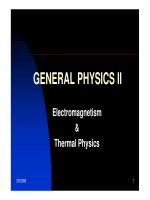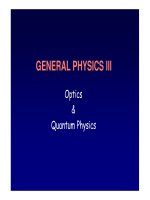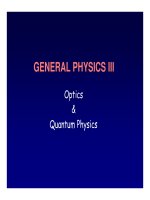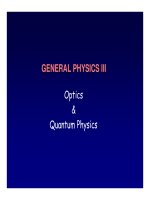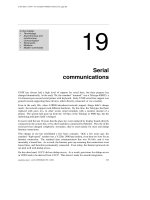- Trang chủ >>
- Khoa Học Tự Nhiên >>
- Vật lý
Tài liệu Chapter IX Conductors, Capacitors ppt
Bạn đang xem bản rút gọn của tài liệu. Xem và tải ngay bản đầy đủ của tài liệu tại đây (549.02 KB, 27 trang )
2/20/2008 1
GENERAL PHYSICS II
Electromagnetism
&
Thermal Physics
2/20/2008 2
Chapter IX
Conductors, Capacitors
§1. Charges and electric field on conductors
§2. Capacitance of conductors and capacitors
§3. Energy storage in capacitors and electric field energy
§4. Electric current, resistance and electromotive force
2/20/2008 3
§1. Charges and electric field on conductors:
1.1 The balance of charges on conductors:
In conductors there are charged particles which can be freely
move under any small force. Therefore the balance of charges on
conductors can be observed under these circumstances:
The electric field equals zero everywhere inside the conductor
E = 0
The electric potential is constant inside the conductor
V = const
The electric field vector on the surface of conductors direct along the
normal of the surface at each point
E = En
The surface of conductors is equipotential
Inside conductors there is no charge. This conclusion can be proved
by applying the Gauss’s law for any arbitrary closed surface inside
conductor. All the charge is distributed on the surface of conductors.
2/20/2008 4
Since the distribution of charge on conductors
does not depend on the distribution of the
matter the distribution of charges is
the same for hollow and solid conductors.
The fact that the distribution of charges only
on the surface of conductors can be
understood as follows:
Suppose that we provide the conductor with
an amount of charges charges repulse
mutually and tend to leave as far as possible
each from other.
2/20/2008 5
1.2 The electric field at the surface of
a conductor:
Consider the red small cylindrical surface
with the base dS. Applying the Gauss’s law
for this closed surface we have
The electric field in vacuum
near the surface
The electric field in dielectric
environment near the surface
(σis the surface charge density
at the considered point on the
surface)
σ
+ Near convexes of the surface:
the equipotential surfaces are
dense E is large
the charge density is large
+ Near deepenings of the surface:
the equipotential surfaces are
rare E is smaller
the charge density is small
2/20/2008 6
§2. Capacitance of conductors and capacitors:
2.1 Charging by induction:
A charge body (rod) can give
another body a charge of
opposite sign, without losing
any of its own charge.
Pictures:
a) Metal sphere is initially uncharged
b) Charged rod brought nearby
c) Wire allows piled-up electrons to
flow to ground
d) Wire is disconnected from sphere
e) Charged rod is removed: Electrons
on sphere rearrange themselves.
Metal sphere
Isulating
stand
Negatively
charged
rod
a)
b)
c)
d)
e)
wire
2/20/2008 7
2.2 Capacitors and capacitance:
A capacitor is a device whose purpose is to store electrical energy which
can then be released in a controlled manner during a short period of time.
A capacitor consists of 2 spatially separated conductors which can be
charged to +Q and -Q respectively.
Definition: The capacitance of the capacitor is the ratio of the charge on one
conductor of the capacitor to the potential difference between the
conductors:
V
Q
C
• The capacitance belongs only to the capacitor, independent of the charge
and voltage.
[The unit of capacitance is the
Farad: 1 F = 1C/V]
2/20/2008 8
Example 1: Parallel Plate Capacitor
• Calculate the capacitance. We assume
+
, -
charge densities on each plate
with potential difference V :
d
A
- - - - -
+ + + +
V
Q
C
Need Q:
Need V: from definition:
Use Gauss’ Law to find E (in next slide)
2/20/2008 9
Recall the formula for the electric field of two infinite sheets:
• Field outside the sheets is zero
Gaussian surface encloses zero net
charge
E=0
E=0
E
+
+
+
+
+
+
+
+
+
+
-
-
-
-
-
-
-
-
-
-
+
+
-
-
-
A
A
AQ
inside
AESdE
• Field inside sheets is not zero:
• Gaussian surface encloses non-zero
net charge
0
E
(Note that here we consider a capacitor in vacuum)
2/20/2008 10
00
A
Q
E
d
A
Q
EdldEVV
b
a
ab
0
d
A
V
Q
C
0
Remark:
• The capacitance of this capacitor depends only on its shape and size
• This formula is true for parallel-plate capacitor (shape), and C depends
on A, d (size) (for another shape one has other formula).
• When the space between the metal plates is filled with a dielectric
material, the capacitance increases by a factor k (see the previous chapter)
(Recall: k - dielectric constant; ε- permitivity of the dielectric)
In order to increase C d (limitatively), and one must increase A, ε.





